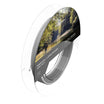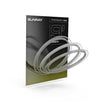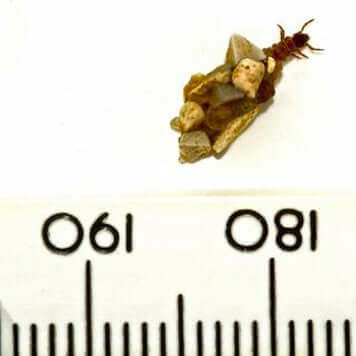As an enthusiastic fisher of tiny flies I had long been aware of 5mm long Micro-caddis of the genus Agapetus, but it was not until a few years ago that Stuart Crofts (probably the UK’s top expert on Caddis flies) enlightened me to the fact that the vulnerable stage in their lifecycle is the pupa as it swims to the bankside vegetation where it will transpose into the adult. Furthermore Stuart has devised the perfect fly to imitate these tiny (5mm long) pupae as they swim in the surface film towards the riverbank.

Agapetus larva
The three UK representatives of this genus, Agapetus fuscipes, Agapetus ochripes & Agapetus delicatulus are all very similar. Their larvae make tiny igloo-like cases from tiny particles of gravel. In summer on my local East Yorkshire chalk stream there are so many chalk gravel cases to be seen that the Ranunculus beds often look as though they are covered with dandruff & 3 minute kick samples contain up to 8000 of the cased larvae. The tiny moth-like adults are rarely seen on the water, but during the summer may be found scuttling about in the bankside vegetation. The pupae are what we anglers need to be aware of if our rivers contain them in any significant numbers (look for 5mm pebble igloos covering the rocks in the river to check their abundance).

Agapetus pupa
Emergence in East Yorkshire starts in early May during the daytime & continues till late summer with two peaks of activity around June & August. The main sign that the fish are focused on emerging pupae is when you see fish rising quite aggressively to what I call ‘invisibles’ (rises to black gnats, midges & spent spinners are usually quite leisurely). A further sign is that your Midge/Aphid/Spinner pattern is being completely ignored despite accurate casting & drag-free presentation, although you might get an occasional response to a small dry fly just as it starts to drag. A final sign is that fish preoccupied with Agapetus pupae are virtually impossible to spook even by careless casting.

Agapetus adult
Stuart’s Agapetus pupa
This imitation is tied on a size 20 Partridge SLD or similar hook, with fine orangy-brown dubbing (I usually use brown), 2 CdC kicking legs each side (or 1 each side of microflash) & 2 mini white poly yarn posts. The body is wetted with saliva so that it sinks & a touch of floatant is applied to the tips of the posts to hold the fly horizontally in the surface film (Stu is a genius at fly design: simple & effective!). Fish it up & across dead-drifted with frequent small pulls to make it swim (they swim remarkably fast for their size). Expect vigorous takes so take care when striking since you’ll probably be using 6x tippet. A long, softish, 2 or 3 weight rod is ideal for this fishing to protect the fine tippet & aid subtle manipulations (thick, heavy lines tend to damp down the fine movements required to simulate natural movement). Tenkara is an alternative if the fish aren’t too big & I’ll tell you in detail how good this is for subtle induced movements another time. A further way to enhance the presentation is to tie your Agapetus imitation into a loop knot (Rapala knot or Perfection Loop) to give it more freedom to move.

Stu Crofts Agapetus Pupa
Don’t think it is just small fish that get focused on Agapetus pupae: the biggest fish in the river will come out for this feast. So check if you’ve got them & tie some imitations up ready.
Next time I’m going to go to the other extreme, telling you about how I use huge, buoyant dry flies to fish the turbulent pocket water of Alpine rivers in Austria & Northern Italy for brown trout, rainbow trout & brook trout.
































